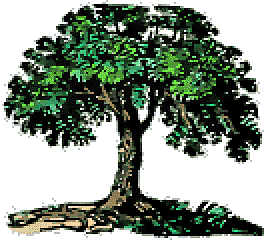|
Shade Trees Home Page | Selecting Trees for Biodiversity | Pick A Tree | Read About Biodiversity Shade Trees and Biodiversity in the Urban EnvironmentWhat is Biodiversity?
BIOLOGICAL DIVERSIFICATION IS STILL A MAJOR TOOL TO EMPLOY IN PROTECTING YOUR COMMUNITY'S FOREST Why we Need BiodiversityINTRODUCTION - Research has not yet quantified what the actual benefits of a more diversified urban landscape planting are. Yet it is generally acknowledged that having more different species and genera in the community forest will reduce maintenance costs. Clearly, we must protect our communities from the impact of another disease such as Dutch elm disease that destroyed a large percentage of the American elms that once lined American streets. The rapid devistation of this disease was due largely in part to the fact that the Americal Elm was over-planted, and the pathogen spread through rapidly through the urban elm monoculture. The current potential catastrophe in the midwest is the maple that, for a variety of reasons, currently comprises 80% of the mature urban forest canopy. This was noted in early tree inventories conducted by the State Urban Foresters in some of Ohio's smaller communities. Increased diversification is needed to protect an important community asset - the urban forest. How Diverse is Diverse?You may wish to aim for the 10-20-30 rule as a guide. This rule states that no more than 10% of the urban forest should be of the same species. Further, no more than 20% of the forest should be of the same genera, and a single family should not make up more than 30% of the community's tree inventory. Following these guidelines will result in a more biologically diverse planting. Many diseases and insect pests tend to choose trees by family. Furthermore, quasi-resistant species in the same family may continue to be sources for pathogens and insects that could affect other trees in the same family. Nowhere is this phenomenon more evident than in the American chestnut blight disaster. The pathogen for this disease continues to be harbored in other trees in the same family which comprise a significant percenentage of the forest canopy. These "carrier" trees do not succumb to the disease, but they continue to spread it to young chestnut trees, and have reduced this once dominant climax community tree to a minor understory plant. This could happen in our cities as well. Finding New Plants to Increase Your Urban DiversityMany city foresters have been frustrated in recent years in their attempt to diversify their urban forest's species mix. When a new plant is requested from a nursery producer, the common response has been "No one has ever asked for that one before." The nursery industry now produces a relatively restricted pallet of trees for sale. There is blame to share for that reduced diversity if that is your desire. Growers find it less costly to maintain a less diverse inventory. Raising a seedling is a risk, but raising a seedling for which there is no known market is a greater risk. Customers have not communicated their needs in a timely fashion. Customers forget that they requested a new plant. Cities are unwilling to take a chance on a new plant and thus fail to support the grower who does take the risk of offering a new plant. Municipal budgets also vary from year-to-year forcing unforeseen cutbacks in the annual demand for trees, etc. In order to increase diversity we must provide timely guidance to the nursery producers so that they might know what is needed and can have the trees you want in inventory at the time you need them. Advanced planning is necessary since it can take three to eight years to produce a two-inch caliper tree. Cities must do their part and make a commitment to increasing diversity. Try committing to a minimum of 10% of each year's new plantings with trees that you have not tried previously. They may cost more initially, due to the increased risks that the grower has assumed, but costs will come down as the trees move into general production. If your community is one with a heavy dependence on a limited number of species, Even larger percentages of new plants (20-30%) should be considered. Shade Trees Home Page | Selecting Trees for Biodiversity | Pick A Tree | Read About Biodiversity
T. Davis Sydnor, Ph. D. and Nick E. D'Amato
|